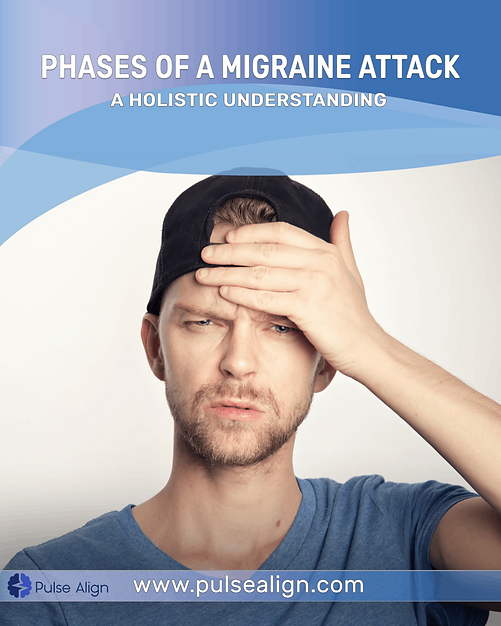Recognizing the distinct phases of a migraine attack is essential for effective management.
Migraines are widespread and distressing neurological disorders characterized by severe headaches and associated symptoms.
These phases include prodrome, aura, headache, and postdrome, each with its unique set of symptoms. Viewing these symptoms as indicators of overall well-being allows for a holistic approach to migraine management.
Introducing the Pulse Align approach, which emphasizes addressing root causes rather than just symptom relief. Pulse Align considers physical, emotional, and lifestyle factors, aiming for a balanced state of well-being.
By the end of this guide, you’ll have a deep understanding of migraine phases, the importance of holistic well-being, and how Pulse Align can contribute to it.
The Phases of a Migraine Attack
Migraine attacks typically unfold in four distinct phases, each with its unique characteristics and implications for well-being. Understanding these phases is crucial for managing migraines effectively and promoting overall health.
A. Prodrome Phase
Definition and Duration: The prodrome phase is the initial stage of a migraine attack, preceding the headache itself. It can last for hours or even days before other symptoms become evident.
Prevalence Statistics and Studies: Studies indicate that approximately 60% of migraine sufferers experience prodrome symptoms. Reference: American Migraine Foundation
Symptoms and Their Significance: Common prodrome symptoms include mood changes, food cravings, and fatigue. These symptoms are essential indicators of an impending migraine and underscore the link between physical and emotional well-being.
B. Aura Phase
Definition and Characteristics: The aura phase is characterized by neurological disturbances, such as visual disturbances (flashing lights, blind spots), sensory changes, or difficulty speaking. These symptoms usually precede the headache phase.
Statistics on Aura Occurrence: Auras occur in approximately 20% of migraine cases, adding a unique dimension to the migraine experience.
Aura’s Connection to Overall Well-Being: Understanding auras’ impact on overall well-being sheds light on the intricate relationship between neurological function and migraine attacks.
C. Headache Phase
Duration and Intensity: The headache phase is the most recognizable aspect of a migraine attack, marked by severe head pain. It can last from a few hours to several days and varies in intensity.
Studies on the Impact of Headaches: Numerous studies have shown the profound impact of migraine headaches on an individual’s quality of life, highlighting the need for effective management.
Headache as an Indicator of Underlying Issues: The headache phase should not be viewed in isolation but as a symptom reflecting underlying physiological and environmental factors that contribute to migraine attacks.
D. Postdrome Phase
Post-Migraine Symptoms and Their Prevalence: The postdrome phase occurs after the headache subsides and is characterized by lingering symptoms such as fatigue, cognitive difficulties, and mood changes.
Understanding Postdrome’s Importance: Recognizing the postdrome phase is vital, as it provides insights into the extended impact of migraines on an individual’s well-being, emphasizing the need for holistic management approaches.
By delving into each phase of a migraine attack, we gain a more comprehensive understanding of the condition and its multifaceted effects on well-being. This knowledge serves as a foundation for exploring holistic approaches like Pulse Align, which address the root causes of migraines for more effective and lasting relief.
The Pulse Align Approach
Pulse Align is a holistic and integrative approach to managing migraines that focuses on addressing root causes rather than solely alleviating symptoms. By understanding the key components of Pulse Align, you can appreciate how it contributes to a comprehensive and sustainable approach to migraine management.
A. What is Pulse Align?
Brief Explanation of the Approach: Pulse Align is a multifaceted approach that recognizes migraines as complex conditions influenced by various factors, including physical, emotional, and lifestyle elements. It goes beyond symptomatic relief and aims to bring the body and mind into harmony for long-term well-being.
B. Addressing Root Causes
Emphasizing the Holistic Approach: Pulse Align places a strong emphasis on holistic well-being, acknowledging that migraines often result from a combination of physical, emotional, and lifestyle factors.
How Pulse Align Addresses Root Causes: Pulse Align employs a multidisciplinary approach, incorporating strategies such as dietary adjustments, stress management, and personalized therapies to target the underlying triggers of migraines. By identifying and addressing these root causes, Pulse Align helps reduce the frequency and severity of migraine attacks.
C. Benefits of Pulse Align
Reduced Symptom Recurrence: Pulse Align’s holistic approach aims to reduce the recurrence of migraine symptoms by addressing their underlying causes. This reduction in symptom frequency leads to a significant improvement in the quality of life for migraine sufferers.
Improving Overall Well-Being, Moving Towards Complete Healing: Pulse Align recognizes that well-being extends beyond the absence of migraine symptoms. It aims for a broader sense of well-being, encompassing physical, mental, and emotional health. This approach ultimately guides individuals toward complete healing, where migraines become less disruptive and less frequent.
Studies Supporting the Effectiveness of Holistic Approaches: Research has shown that holistic approaches like Pulse Align, which considers lifestyle, emotional factors, and dietary modifications, can have a positive impact on migraine management (The Journal of Headache and Pain).
Pulse Align’s commitment to understanding and addressing the root causes of migraines aligns with the holistic perspective of well-being, offering migraine sufferers a promising avenue for achieving lasting relief and improved quality of life.
Holistic Well-Being and Migraine Management of Migraine Attack
Migraines are complex and often debilitating conditions that extend beyond the physical discomfort of a headache. In this section, we delve into the importance of adopting a holistic approach to migraine management, understanding the limitations of symptom-focused treatments, and appreciating the intricate mind-body connection in the context of migraines.
Discussing the Limitations of Symptom-Focused Treatments
While conventional treatments for migraines primarily target symptom relief through painkillers and medications, they often fall short in providing comprehensive and long-lasting solutions. These treatments may provide temporary relief, but they do not address the underlying factors that trigger migraines.
Symptom-focused treatments also have limitations in terms of sustainability. They may lead to overuse of medications, which can result in medication overuse headaches—a cycle that exacerbates the problem rather than resolving it.
Explaining Why Holistic Well-Being Is Essential for a Migraine Attack
Holistic well-being goes beyond the absence of migraine symptoms. It encompasses physical, mental, and emotional health, emphasizing a balanced and harmonious state of being. Adopting a holistic approach recognizes that migraines are not isolated events but manifestations of a broader well-being spectrum.
Achieving holistic well-being involves making lifestyle adjustments, managing stress, optimizing nutrition, and nurturing emotional health. It acknowledges that factors such as sleep, diet, exercise, and mental well-being play pivotal roles in migraine management.
Insights into the Mind-Body Connection and Its Role in Migraines
The mind-body connection is a fundamental aspect of understanding migraines. Stress, anxiety, and emotional triggers can significantly impact the frequency and severity of migraine attacks. Stress, in particular, is a common trigger, and its effects on the body can lead to physiological changes that promote migraines.
Recognizing the mind-body connection underscores the importance of stress management, relaxation techniques, and mindfulness practices in migraine management. By addressing emotional and psychological factors, individuals can reduce the frequency of migraines and enhance their overall well-being.
Incorporating holistic well-being into migraine management is not only about treating symptoms but also about creating a life that fosters long-term health and resilience. By adopting a holistic perspective, individuals can minimize the impact of migraines on their lives and work towards a future with fewer and less severe migraine attacks.
The Role of Lifestyle Changes
Lifestyle changes are a pivotal aspect of effective migraine management. In this section, we briefly encourage readers to explore lifestyle modifications and their synergy with the Pulse Align approach. We also touch upon the value of real-life success stories and testimonials.
Encouraging Lifestyle Modifications: We highlight the importance of considering lifestyle changes as part of a holistic approach to managing migraines.
Complementing Pulse Align: Lifestyle modifications can complement Pulse Align by reducing migraine triggers and promoting overall well-being.
Real-Life Success Stories: We briefly mention the value of real-life success stories and testimonials, showcasing how lifestyle changes, alongside Pulse Align, have led to improved well-being and fewer migraine occurrences.
By making practical adjustments in their daily lives, individuals can enhance the effectiveness of their migraine management strategies and experience real improvements in their overall well-being.
Conclusion – Migraine Attack
Migraine management goes beyond treating headaches. We’ve uncovered the value of holistic approaches, the limitations of symptom-focused treatments, and the intricate mind-body connection.
Pulse Align offers a holistic path by addressing root causes, while lifestyle changes complement it. Real-life success stories show the potential for lasting relief.
In conclusion, a holistic perspective empowers you to regain control over your well-being, reducing the impact of migraines for a brighter, migraine-free future.
World Health Organization. (2016). Headache Disorders. https://www.who.int/en/news-room/fact-sheets/detail/headache-disorders
American Migraine Foundation. (n.d.). Understanding Migraine: The Basics. https://americanmigrainefoundation.org/resources/
Johnson, A. J., & Silverstein, J. H. (2019). Migraine headache. In StatPearls. https://www.ncbi.nlm.nih.gov/books/NBK430900/
Pulse Align. (n.d.). About Us. https://pulsealign.com/about-us/
Migraine Research Foundation. https://www.sciencedirect.com/topics/neuroscience/auras#:~:text=The%20aura%20phase%20of%20migraine,%2C%20speech%2C%20or%20motor%20symptoms.
The Journal of Headache and Pain. (n.d.). Holistic Approaches in Migraine Management. https://thejournalofheadacheandpain.biomedcentral.com/articles/10.1186/s10194-020-1077-x
Dodick, D. W. (2018). Migraine. The Lancet, 391(10127), 1315-1330. doi:10.1016/s0140-6736(18)30671-0 https://pubmed.ncbi.nlm.nih.gov/29697154/
Wells RE, Seng EK, Edwards RR, Victorson DE, Pierce CR, Rosenberg L, Napadow V, Schuman-Olivier Z. Mindfulness in migraine: A narrative review. Expert Rev Neurother. 2020 Mar;20(3):207-225. doi: 10.1080/14737175.2020.1715212. Epub 2020 Feb 12. PMID: 31933391; PMCID: PMC7213534. https://www.ncbi.nlm.nih.gov/pmc/articles/PMC7213534/
As the visionary CEO of Pulse Align, François is dedicated to transforming the landscape of pain management and posture health. With a deep-rooted passion for innovation and a commitment to excellence, François leads the team in developing cutting-edge solutions that empower individuals to live healthier, pain-free lives. Under his leadership, Pulse Align has become a beacon of hope and support for those navigating postural-related issues and chronic pain. François brings a wealth of experience in neuromodulation and patient management technologies, combining strategic insight with a compassionate approach to address the unique challenges faced by each individual.



